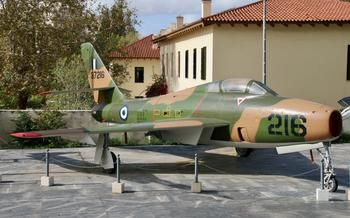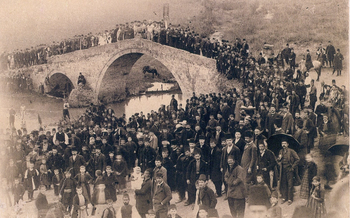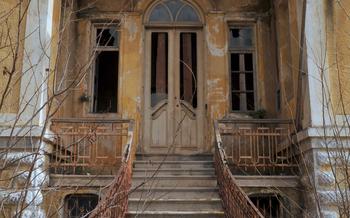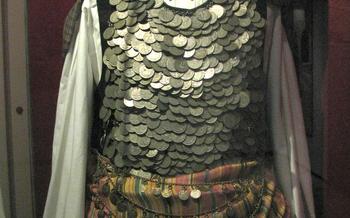
The Folklore Museum of Siatista (nearby attraction)
- History of the museum
- Unveiling the Rich History of Siatista
- Exploring the Museum's Diverse Collections
- Traditional Costumes: A Reflection of Siatista's Heritage
- Handicrafts and Textiles: A Showcase of Local Artisanship
- Domestic and Agricultural Tools: Glimpsing Everyday Life
- Guided Tours: Enhancing Your Museum Experience
- Workshops and Demonstrations: Learning from the Masters
- Temporary Exhibitions: Showcasing Contemporary Expressions
- Museum Shop: Preserving Local Traditions Through Souvenirs
- Educational Programs: Engaging the Younger Generation
- Accessibility: Ensuring Inclusivity for All
- Location and Contact Information:
- Insider Tip: Discovering Hidden Gems
History of the museum
Established in 1975, the Folklore Museum of Siatista is a treasure-trove of cultural artifacts that narrate the captivating story of this historic city and the surrounding region of Macedonia, Greece. Housed in a beautifully restored 19th-century mansion, the museum invites visitors on a journey through time, showcasing the rich traditions, customs, and way of life that have shaped the identity of Siatista. Through its diverse collection, the museum serves as a testament to the enduring legacy of this vibrant city, perpetuating its cultural heritage for generations to come.
Unveiling the Rich History of Siatista
Siatista, a picturesque town in Northern Greece, boasts a rich and multifaceted history that has shaped its unique cultural identity. Once a thriving center of trade and commerce, Siatista was a melting pot of different cultures and influences, leaving an indelible mark on the city's architecture, traditions, and way of life.
Historical Significance: Siatista's strategic location made it a significant trade hub during the Byzantine and Ottoman periods. Its proximity to major trade routes facilitated the exchange of goods and ideas, leading to a vibrant and cosmopolitan atmosphere. The town's prosperous merchants and artisans contributed to its economic and cultural growth, leaving behind a legacy of impressive mansions and ornate churches that still stand today.
Cultural Influences: As a crossroads of cultures, Siatista absorbed influences from various communities, including Greeks, Vlachs, Turks, and Jews. This cultural tapestry is reflected in the town's diverse architecture, cuisine, and customs. The fusion of different traditions gave rise to unique artistic expressions and a rich intangible cultural heritage that continues to be celebrated and preserved.
Notable Figures and Events: Siatista has been home to many notable figures who made significant contributions to Greek society. Among them is the renowned Greek poet and writer, Kostas Krystallis, whose works have left an enduring mark on Greek literature. The town also played a significant role during the Greek War of Independence, as it was a refuge for many fighters and civilians seeking shelter from Ottoman oppression.
The City's Transformation: In the late 19th and early 20th centuries, Siatista experienced a period of decline as trade routes shifted and new economic centers emerged. However, the town's rich cultural heritage remained intact, and in recent years, there has been a renewed interest in preserving and promoting its unique identity. Today, Siatista is a charming and vibrant town that attracts visitors from around the world who come to explore its historical treasures and experience its warm hospitality.
Exploring the Museum's Diverse Collections
The Folklore Museum of Siatista boasts a treasure trove of artifacts that provide a fascinating glimpse into the rich cultural heritage of the region. Traditional costumes, intricate handicrafts, domestic and agricultural tools, and religious artifacts are carefully curated and displayed, offering visitors a comprehensive exploration of Siatista's past.
The collection of traditional costumes is a highlight, showcasing the unique designs and styles that have been passed down through generations. These elaborate garments, intricately embroidered and adorned with vibrant colors, reflect the artistry and craftsmanship of Siatista's people. Visitors can admire the intricate details and symbolism embedded in each piece, gaining insights into the social and cultural significance of these traditional attires.
Handicrafts and textiles form another significant part of the museum's collection. Exquisite embroidery, intricate weaving, and delicate lacework showcase the exceptional skills of local artisans. Visitors can marvel at the intricate patterns and designs, each piece a testament to the patience and dedication of the craftspeople. These handmade items, ranging from decorative textiles to functional objects, offer a glimpse into the rich artistic traditions of Siatista.
Traditional Costumes: A Reflection of Siatista's Heritage
The Folklore Museum of Siatista boasts an impressive collection of traditional costumes, each a testament to the city's rich cultural heritage. These garments, meticulously crafted by skilled artisans, showcase unique designs and styles that have been passed down through generations. The vibrant colors, intricate embroidery, and delicate fabrics reflect the artistry and creativity of Siatista's people.
Beyond their aesthetic appeal, these costumes hold deep symbolic meaning, representing various aspects of local identity and tradition. The intricate patterns and motifs often carry symbolic significance, reflecting the wearer's marital status, social standing, or religious beliefs. The museum's collection includes costumes for everyday wear, as well as elaborate ceremonial attire worn during festivals and celebrations.
These traditional costumes play a vital role in preserving and showcasing Siatista's cultural legacy. They are not merely relics of the past but living expressions of a vibrant heritage that continues to shape the city's identity. By displaying these costumes, the museum celebrates the artistry, craftsmanship, and cultural diversity that make Siatista a unique and captivating destination.
Handicrafts and Textiles: A Showcase of Local Artisanship
The Folklore Museum of Siatista not only houses an impressive collection of traditional costumes but also showcases the exquisite craftsmanship of local artisans through its display of handicrafts and textiles. Visitors can admire intricate embroidery and weaving, which are hallmarks of Siatista's artistic heritage. These textiles, created using techniques passed down through generations, range from colorful rugs and tapestries to delicate lace and intricate needlework.
The museum's collection includes examples of traditional clothing adorned with intricate embroidery, as well as decorative items such as tablecloths, bedspreads, and cushions. Each piece reflects the skill and artistry of the local craftspeople, who have preserved these traditional techniques over time. Visitors can purchase souvenirs and keepsakes featuring these traditional designs, supporting local artisans and taking a piece of Siatista's rich cultural heritage home with them.
Domestic and Agricultural Tools: Glimpsing Everyday Life
The museum's collection of domestic and agricultural tools provides a fascinating glimpse into the daily lives of Siatista's people. These implements, once essential to the functioning of traditional households and farms, offer insights into the region's rich agricultural heritage.
Among the domestic tools on display are various cooking utensils, ceramic and metal tableware, and traditional furniture. These artifacts reveal the ingenuity and craftsmanship of local artisans, who created functional and aesthetically pleasing objects for everyday use.
The agricultural tools showcase the region's farming traditions. From simple hand tools to more complex machinery, these implements tell the story of the hard work and dedication of Siatista's farmers. Visitors can see plows, scythes, threshing machines, and other tools that were once indispensable for cultivating the land and harvesting crops.
Collectively, these domestic and agricultural tools offer a tangible connection to the past, preserving the memory of the people who used them and the ways of life they represented. They serve as a reminder of the importance of agriculture in Siatista's history and the enduring legacy of the region's traditional crafts.
Guided Tours: Enhancing Your Museum Experience
To make the most of your visit to the Folklore Museum of Siatista, consider booking a guided tour. Knowledgeable guides are available to provide insightful commentary on the museum's exhibits and history. They can share stories and anecdotes that bring the collection to life, offering a deeper understanding of the region's culture and heritage.
Guided tours are especially beneficial for groups or individuals interested in learning more about the specific artifacts on display. Guides can tailor the tour to your interests, whether you're fascinated by traditional costumes, handicrafts, or religious artifacts. They can also answer your questions and provide additional context, enhancing your overall museum experience.
Workshops and Demonstrations: Learning from the Masters
Beyond the static displays, the Folklore Museum of Siatista offers a dynamic and interactive experience through its workshops and demonstrations. These hands-on sessions provide visitors with an opportunity to learn from the masters themselves—local artisans who have dedicated their lives to preserving traditional crafts. Under their expert guidance, participants can engage in the creative process, trying their hand at embroidery, weaving, pottery, or other traditional arts. These workshops are not just about acquiring new skills; they are about connecting with the cultural heritage of Siatista, gaining a deeper appreciation for the skill and dedication required to create these beautiful objects. Whether you're a seasoned artisan or a curious beginner, these workshops offer a unique and enriching experience that will leave you with lasting memories and a newfound respect for the artisans of Siatista.
Temporary Exhibitions: Showcasing Contemporary Expressions
The Folklore Museum of Siatista not only preserves the cultural heritage of the past but also embraces the creative spirit of the present. Temporary exhibitions are regularly organized to showcase the works of local and regional contemporary artists. These exhibitions provide a platform for emerging talents to display their unique interpretations and perspectives, fostering a vibrant dialogue between tradition and innovation.
Visitors can explore a diverse range of artistic expressions, from modern paintings and sculptures to experimental installations and multimedia projects. These exhibitions offer a glimpse into the contemporary cultural landscape of Siatista and the broader region, encouraging visitors to engage with fresh ideas and challenge their perceptions of traditional art forms.
The temporary exhibitions at the Folklore Museum of Siatista are not just showcases for artistic talent; they are spaces for cultural exchange and dialogue. Through interactive installations, workshops, and artist talks, visitors are invited to engage with the creative process and gain insights into the minds of the artists. These exhibitions foster a sense of community and create a platform for discourse on contemporary art and its role in shaping our understanding of the past and the present.
Museum Shop: Preserving Local Traditions Through Souvenirs
In the museum's dedicated shop, visitors can delve deeper into the rich heritage of Siatista by purchasing authentic souvenirs that embody the region's artisanal traditions. These carefully curated items serve as tangible mementos of the museum experience, allowing visitors to take a piece of Siatista's culture home with them. From intricately embroidered textiles and hand-woven tapestries to intricate pottery and finely crafted jewelry, each souvenir represents the exceptional craftsmanship and artistry that Siatista is renowned for.
By purchasing these unique items, visitors not only support the museum's mission of preserving and promoting local heritage but also contribute directly to the livelihoods of local artisans. Every purchase made helps sustain the vibrant traditions that define Siatista's cultural identity. The museum shop thus becomes a vital platform for empowering local craftspeople, ensuring the continuation of their invaluable skills, and fostering a sense of pride in their cultural heritage.
Educational Programs: Engaging the Younger Generation
Recognizing the importance of cultural education, the Folklore Museum of Siatista offers a range of educational programs tailored for students of all ages. These programs aim to promote cultural awareness, appreciation, and understanding among the younger generation, ensuring the continuity of Siatista's rich heritage.
Interactive activities and workshops form the core of these educational initiatives. Children and students engage in hands-on experiences, learning about traditional crafts, customs, and the history of Siatista. Through storytelling, role-playing, and other interactive methods, the museum brings the past to life, fostering a sense of connection and curiosity.
School groups are particularly encouraged to participate in these programs, which can be customized to fit specific curriculum needs. The museum's knowledgeable staff collaborates with teachers to design educational experiences that align with school curricula, making learning both enjoyable and effective.
By engaging the younger generation, the Folklore Museum of Siatista plays a vital role in preserving and transmitting the cultural legacy of the city. These educational programs inspire the next generation of cultural custodians, ensuring that the traditions and heritage of Siatista continue to thrive for years to come.
Accessibility: Ensuring Inclusivity for All
The Folklore Museum of Siatista understands the importance of inclusivity and accessibility for all visitors, regardless of their abilities. The museum is committed to creating a welcoming environment where everyone can enjoy the richness of Siatista's cultural heritage.
To cater to the needs of visitors with disabilities, the museum has implemented several accessibility features. Ramp access ensures that wheelchair users can easily navigate the museum's premises. Braille signage provides tactile information about the exhibits and the museum's layout, enabling visually impaired visitors to explore independently. Additionally, audio guides are available to offer detailed descriptions of the exhibits, enhancing the experience for both visually and hearing-impaired visitors.
By embracing inclusivity, the Folklore Museum of Siatista ensures that everyone has the opportunity to immerse themselves in the fascinating history and traditions of this vibrant city. Visitors are encouraged to reach out to the museum's staff if they have any specific accessibility requirements or questions, as the museum is dedicated to providing a seamless and enjoyable experience for all.
Location and Contact Information:
The Folklore Museum of Siatista is situated in the heart of the picturesque town of Siatista, approximately 110 kilometers southwest of Thessaloniki. Visitors can easily reach the museum by car, following the national road from Thessaloniki to Kozani. The museum is conveniently located near the town's main square, making it accessible on foot or by public transportation. For further inquiries or to arrange guided tours, you can contact the museum at [phone number] or visit their website at [website address]. The museum is open to the public daily, except for Mondays, from 10:00 am to 5:00 pm. Admission fees are minimal and contribute to the preservation and maintenance of the museum's collection.
Insider Tip: Discovering Hidden Gems
Beyond the museum's walls, Siatista unveils a treasure trove of hidden gems waiting to be discovered. Wander through the town's enchanting streets, lined with charming traditional houses adorned with intricate carvings and colorful facades. Around every corner, you'll find a new surprise, whether it's a cozy café, a quaint boutique, or a hidden courtyard.
For those interested in history and architecture, Siatista boasts several impressive Byzantine churches. The Church of the Assumption of the Virgin Mary stands as a testament to the town's rich religious heritage, with its stunning frescoes and intricate iconography. The Church of Saint Nicholas, with its unique double-nave design, is another must-see for architecture enthusiasts.
Indulge in the local culinary delights at one of Siatista's traditional tavernas. Savor the flavors of regional specialties like "giaprakia" (stuffed vine leaves), "tourlou" (a hearty vegetable stew), and "kolokithopita" (zucchini pie). Pair your meal with a glass of local wine, and you'll experience the true essence of Siatista's culinary traditions.
The warmth and hospitality of the locals are what make Siatista truly special. Engage in conversations with the friendly residents, and you'll quickly feel like part of the community. They'll gladly share stories, recommendations, and insights into the town's unique way of life.
Embrace the opportunity to immerse yourself in the authentic charm of Siatista. Discover its hidden gems, embrace the local culture, and create memories that will last a lifetime.






